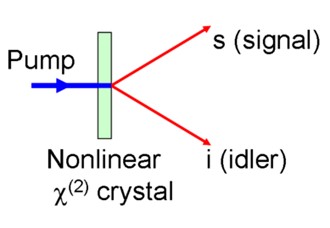Entangled photon sources for quantum communications
- Posted by Javier Alejandro de la Ossa Fernández
- On December 14, 2022
- 0
Quantum entanglement is one of the many non-intuitive features of quantum mechanics. If two photons of light are allowed to properly interact with each other, they can become entangled. Those two entangled photons can then be separated, but as soon as one of them interacts with the third particle, the other photon of the pair will change its quantum state instantaneously. This happens according to the random outcome of the interaction, even though this photon never did interact with a third particle [1], meaning a message can be swapped with total confidence due to this type of behavior.
This is due to the fact that detecting photons will change the entangled partner if there is a listener eavesdropping on the message. The legitimate receiving station would notice these changes, and the eavesdropper’s presence would be immediately detected.
The European Space Agency has shown a great deal of interest in developing quantum communication for applications in space in recent years and has funded several projects in this field.
Entangled photon pair generation
There are many methods for generating photon pairs, but a non-linear process called Spontaneous Parametric Down-Conversion (SPDC) has become the gold standard and is the most mature.
Even though competing technologies (solid state sources, four-wave mixing sources, etc.) are on the rise as long-term alternatives for the generation of entangled photon pairs, the SPDC-based sources in bulk crystals continue to provide the most promising solution for the high-loss free-space links in the long run, since they are able to meet the challenging performance requirements.
SPDC is a nonlinear instant optical process that converts one photon of higher energy (namely, a pump photon), into a pair of photons (namely, a signal photon and an idler photon) of lower energy.

Schematic of SPDC process (courtesy of Wikipedia)
To generate a pair of photons from a photon beam, a nonlinear crystal is used. According to the laws of energy and momentum conservation, the pairs have combined energies and momenta equal to the energy and momentum of the original photon. Due to the fact that the index of refraction varies with frequency (dispersion), only certain triplets of frequencies will be phase-matched, allowing for simultaneous energy and momentum conservation. The most common method for achieving phase matching is to use birefringent nonlinear materials, such as potassium titanyl phosphate (KTP), lithium niobate (LN) or beta barium borate (BBO), whose index of refraction changes with polarization. As a result, the polarizations of the input photon (the pump) and the two output photons distinguish different types of SPDC (signal and idler).
Due to its large nonlinearity, good transparency for pump wavelengths around 405nm, and low susceptibility to photo-refractive damage, some authors [2] propose using KTP for space-suitable entanglement photon sources (EPC). Furthermore, it has been shown that KTP can sustain the proton and gamma radiation and thermal vacuum fluctuations expected in space.
Alter Technology’s role in space quantum communications
Alter Technology is the prime contractor of a consortium for developing a compact, robust, and reliable Quantum Photonic Transceiver (QPT) capable of generating and detecting secure encrypted keys for its use in space communications under the frame of the ARTES program.
The ARTES program transforms investment in research and development into successful commercial products and services by offering varying degrees of support to projects with different operational and commercial maturity levels.
GET IN TOUCH TODAY!
Do you have questions? Contact us!
References:
- https://www.esa.int/Enabling_Support/Preparing_for_the_Future/Discovery_and_Preparation/ESA_takes_steps_toward_quantum_communications
- https://www.researchgate.net/publication/303705273_Development_of_a_space-proof_polarization-entangled_photon_source
- https://en.wikipedia.org/wiki/Spontaneous_parametric_down-conversion
- Entangled photon sources for quantum communications - December 14, 2022
- Using optical transceiver technology within space vehicles - November 8, 2022
- Issue 224 of ESCC QUALIFIED PART LIST (QPL) - March 21, 2022

0 comments on Entangled photon sources for quantum communications